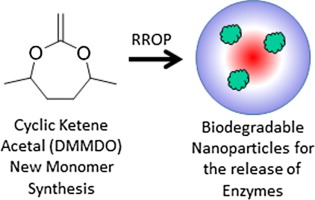当前位置:
X-MOL 学术
›
Eur. Polym. J.
›
论文详情
Our official English website, www.x-mol.net, welcomes your feedback! (Note: you will need to create a separate account there.)
Revisiting Monomer Synthesis and Radical Ring Opening Polymerization of Dimethylated MDO Towards Biodegradable Nanoparticles for Enzymes
European Polymer Journal ( IF 6 ) Pub Date : 2018-04-01 , DOI: 10.1016/j.eurpolymj.2018.02.015 Jens Gaitzsch , Pascale C. Welsch , Jenny Folini , Cora-Ann Schoenenberger , James C. Anderson , Wolfgang P. Meier
European Polymer Journal ( IF 6 ) Pub Date : 2018-04-01 , DOI: 10.1016/j.eurpolymj.2018.02.015 Jens Gaitzsch , Pascale C. Welsch , Jenny Folini , Cora-Ann Schoenenberger , James C. Anderson , Wolfgang P. Meier

|
Abstract Radical ring opening polymerization is a powerful tool to achieve a polyester via radical polymerization. We used it to obtain a dimethylated version of poly(caprolactone) (PdmCL) from dimethylated MDO (DMMDO). First, we revisited monomer synthesis and achieved a milder synthetic protocol by introducing a cobalt-based catalyst. We also developed a new route towards DMMDO via a cyclic carbonate using the Petasis chemistry. Amphiphilic block-copolymers were then generated by free radical polymerization of DMMDO with a PEG-based macroinitiator. The resulting polyesters self-assembled into nanoparticles that were biodegradable as well as biocompatible. The nanoparticles proved to be an effective protective shell for an entrapped enzyme that was released upon degradation of the polyester by esterase. We are confident that our results will spur further research into block-copolymers resulting from RROP.
中文翻译:

重新审视二甲基化 MDO 的单体合成和自由基开环聚合以制备可生物降解的酶纳米颗粒
摘要 自由基开环聚合是通过自由基聚合制备聚酯的有力工具。我们用它从二甲基化 MDO (DMMDO) 中获得了聚(己内酯)(PdmCL)的二甲基化版本。首先,我们重新审视了单体合成,并通过引入钴基催化剂实现了更温和的合成方案。我们还使用 Petasis 化学通过环状碳酸酯开发了一条通往 DMMDO 的新路线。然后通过 DMMDO 与基于 PEG 的大分子引发剂的自由基聚合生成两亲性嵌段共聚物。所得聚酯自组装成可生物降解和生物相容性的纳米颗粒。纳米颗粒被证明是一种有效的保护壳,可以有效地保护酯酶降解聚酯时释放的酶。
更新日期:2018-04-01
中文翻译:

重新审视二甲基化 MDO 的单体合成和自由基开环聚合以制备可生物降解的酶纳米颗粒
摘要 自由基开环聚合是通过自由基聚合制备聚酯的有力工具。我们用它从二甲基化 MDO (DMMDO) 中获得了聚(己内酯)(PdmCL)的二甲基化版本。首先,我们重新审视了单体合成,并通过引入钴基催化剂实现了更温和的合成方案。我们还使用 Petasis 化学通过环状碳酸酯开发了一条通往 DMMDO 的新路线。然后通过 DMMDO 与基于 PEG 的大分子引发剂的自由基聚合生成两亲性嵌段共聚物。所得聚酯自组装成可生物降解和生物相容性的纳米颗粒。纳米颗粒被证明是一种有效的保护壳,可以有效地保护酯酶降解聚酯时释放的酶。


























 京公网安备 11010802027423号
京公网安备 11010802027423号